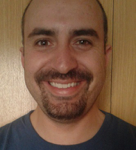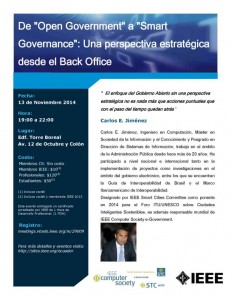IEEE EMBS Ecuador tiene el agrado de invitar a la serie de webinars:
Portal Vein contribution to hepatic perfusion estimated using a Triple Inversion Recovery ASL Technique.
Daniel Aguirre, PhD (c)
Día: 14 de Mayo 2015
Hora: 9.00 GMT-5
About the Webinar: The increase in the intrahepatic blood flow resistance in chronic liver disease has been identified as one of the most sensitive parameters to detect liver cirrhosis progression. Portal vein liver perfusion is affected very early during the liver diseases progression. This webinar explore the feasibility of selectively visualizing the intrahepatic portal vein and estimating its intrahepatic volume in healthy subjects and patients with cirrhosis as a marker of liver perfusion, using a new Arterial Spin Labeling technique without the need of subtraction (TIR-ASL)
About the presenter:
 Daniel Aguirre holds a Master of Science in Medical Physics from the Universidad de Buenos Aires (Argentina). He works as a teacher-researcher in the Computation Science and Electronic Department at the Universidad Técnica Particular de Loja and since 2012 he has been developing his PhD research in the Biomedical Imaging Center at the Pontificia Universidad Católica de Chile (Chile). He is a Ph. D. Candidate since 2014. His research is focused in Digital Signal Processing from Magnetic Resonance Spectroscopy and Magnetic Resonance Imaging with the aim to quantify and characterize the hepatic steatosis in liver.
Daniel Aguirre holds a Master of Science in Medical Physics from the Universidad de Buenos Aires (Argentina). He works as a teacher-researcher in the Computation Science and Electronic Department at the Universidad Técnica Particular de Loja and since 2012 he has been developing his PhD research in the Biomedical Imaging Center at the Pontificia Universidad Católica de Chile (Chile). He is a Ph. D. Candidate since 2014. His research is focused in Digital Signal Processing from Magnetic Resonance Spectroscopy and Magnetic Resonance Imaging with the aim to quantify and characterize the hepatic steatosis in liver.
Hemodynamics parameter obtained from cardiovascular Magnetic Resonance Imaging
 Julio Sotelo was born in San Fernando, Chile. He received the B.E. degree in Biomedical Engineering and the M.Sc. degree in Biomedical Engineering from the University of Valparaiso, Valparaiso, Chile, in 2009 and 2011 respectively. In 2010, he joined the Department of Biomedical Engineering, University of Valparaiso, as Professor. He is currently Ph.D. candidate and Researcher at Biomedical Imaging Center and the Computational Biomechanics Laboratory in the Pontificia Universidad Catolica de Chile, Santiago, Chile, and the Computational Modeling Group in the King’s College London, England, United Kingdom. His main areas of interest are Bioenginering, Bioinstrumentation, Medical Devices, Fluid Mechanics, Magnetic Resonance Imaging, Biomechanics and Image Processing.
Julio Sotelo was born in San Fernando, Chile. He received the B.E. degree in Biomedical Engineering and the M.Sc. degree in Biomedical Engineering from the University of Valparaiso, Valparaiso, Chile, in 2009 and 2011 respectively. In 2010, he joined the Department of Biomedical Engineering, University of Valparaiso, as Professor. He is currently Ph.D. candidate and Researcher at Biomedical Imaging Center and the Computational Biomechanics Laboratory in the Pontificia Universidad Catolica de Chile, Santiago, Chile, and the Computational Modeling Group in the King’s College London, England, United Kingdom. His main areas of interest are Bioenginering, Bioinstrumentation, Medical Devices, Fluid Mechanics, Magnetic Resonance Imaging, Biomechanics and Image Processing.Image processing of biomedical images
Cristobal Arrieta, PhD (c)
Día: May 28, 2015
Hora: 9:00 GMT-5
About the Webinar: Segmentation of medical images is specially challenging because the images have low resolution, show smooth edges between tissues, and present a high noise level. Additionally, in some cases the visual information is not enough to segment the structure of interest. Level set-based algorithms have shown successful results with low resolution, smooth boundaries and noisy images. However, the insufficient visual information required the use of shape prior knowledge. The comparison between shapes needs to be invariant under translation, scaling and rotation. Common approaches alternate between a level set algorithm and a registration process. This registration process is slow and produces variable results depending on how it is optimized. To avoid the registration process, Cremers et al. (2006) propose an intrinsic alignment approach, which transforms all the shapes into a normalized coordinate system. Unfortunately, they only considered translation and scaling invariance, but not rotation, which is critical in medical images. We added rotation invariance to the Cremers’ approach, generating a new set of equations that allows us to use shape priors in complex medical problems. In this webinar we will show 2D and 3D applications of our new approach on medical images.
About the presenter:
 Cristobal Arrieta obtained his B.Sc and M.Sc. in Electrical Engineering at Pontificia Universidad Catolica de Chile, where he is currently a Ph.D. candidate and Research Assistant in the Biomedical Imaging Center. His areas of interest are image segmentation, active contours, level sets, prior knowledge, and medical imaging.
Cristobal Arrieta obtained his B.Sc and M.Sc. in Electrical Engineering at Pontificia Universidad Catolica de Chile, where he is currently a Ph.D. candidate and Research Assistant in the Biomedical Imaging Center. His areas of interest are image segmentation, active contours, level sets, prior knowledge, and medical imaging.Certificados
Los webinars no tienen costo; sin embargo si se desea certificados de desarrollo profesional (PDH) emitidos por IEEE los costos que rigen son:
- Miembros IEEE – EMBS: USD $5,00
- Miembros IEEE: USD $10,00
- Otros: USD $20,00
Escribir a eventosecuador@ieee.org para acceder al programa de certificados.

